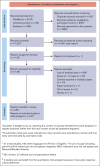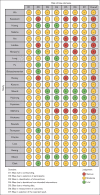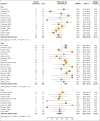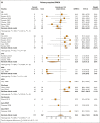Treatment strategy for acquired pure red cell aplasia: a systematic review and meta-analysis
- PMID: 37624775
- PMCID: PMC10632686
- DOI: 10.1182/bloodadvances.2023010587
Treatment strategy for acquired pure red cell aplasia: a systematic review and meta-analysis
Abstract
The treatment of autoimmune acquired pure red cell aplasia (aPRCA) is challenging. Guidelines are based on expert recommendations in the absence of controlled trials. We assessed the efficacy of the main treatment strategy through a systematic review and meta-analysis using MEDLINE, EMBASE, and the Cochrane Library up to September 2022. The overall response rate (ORR) was pooled using random-effects models. In total, 24 observational studies (19 retrospective, median follow-up of 48 months) encompassing 753 patients (49% male) were included. Primary aPRCA represented 57% of the cases. The risk of bias was moderate to high using the ROBINS-I tool. Substantial heterogeneity (I2 > 50%) was retrieved. Corticosteroids as monotherapy as first-line treatment (186 patients, 13 studies) provided an ORR of 47% (95% confidence interval [CI], 34-60). Cyclosporine A was the most frequently used immunosuppressant agent (384 patients, 18 studies), providing an ORR of 74% (95% CI, 66-82) with a similar ORR in first- (73%) and second-line (76%) treatment and when cyclosporin was used as monotherapy (83%) or with corticosteroids (77%). A total of 112 patients (10 studies) received cyclophosphamide, with an ORR of 49% (95% CI, 35-64), which was higher when cyclophosphamide was combined with corticosteroids (48%) and used in second-line treatment (58%) than in monotherapy (31%), and in first-line treatment (44%). Sirolimus use was reported only after cyclosporine A failure and provided an ORR of 87% (95% CI, 68-100; 64 patients, 3 studies). Substantial uncertainty remains regarding the best treatment strategy in the absence of high-quality evidence. This study was registered on the PROPERO database as #CRD42022360452.
© 2023 by The American Society of Hematology. Licensed under Creative Commons Attribution-NonCommercial-NoDerivatives 4.0 International (CC BY-NC-ND 4.0), permitting only noncommercial, nonderivative use with attribution. All other rights reserved.
Conflict of interest statement
Conflict-of-interest disclosure: The authors declare no competing financial interests.
Figures









References
-
- Means RT. Pure red cell aplasia. Blood. 2016;128(21):2504–2509. - PubMed
-
- Means RT, Dessypris EN, Krantz SB. Treatment of refractory pure red cell aplasia with cyclosporine A: disappearance of IgG inhibitor associated with clinical response. Br J Haematol. 1991;78(1):114–119. - PubMed
-
- Lobbes H, Mahévas M, Alviset S, et al. Pure red cell aplasia in systemic lupus erythematosus, a nationwide retrospective cohort and review of the literature. Rheumatology. 2021;61(1):355–366. - PubMed

